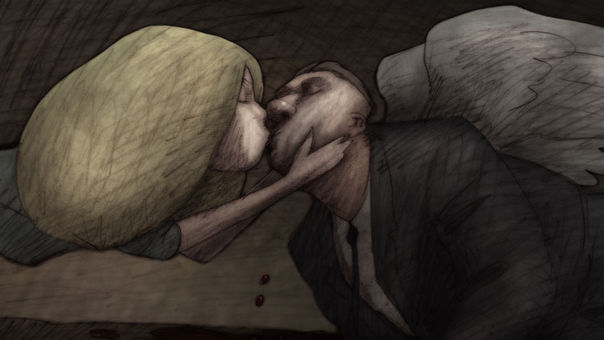The Nausea of the Anunciation
Jaqueline Venet of the 2011 Talent Press Guadalajara reviews Bill Plympton's animated feature film IDIOTS AND ANGELS.

IDIOTS AND ANGELS.
Civilization and its discontent, as well as the solitude of man, trace the symbolic map of a people divided in debate between the utopia that life could be, on the one hand, and what life really is, on the other. An existence is marked by the drought of satisfaction and the most basic institutional motivations. IDIOTS AND ANGELS, like a smoldering ember of violence, carries with it disenchantment and inertia. It is a film about possibility, that space available for a new life. This is accomplished using daily routine as an axis for comparison. Bill Plympton, in his characteristically aggressive universe filled with disillusion, anchors this 2008 feature film in a poetry that dissects the individual. It does so from the least likable aspect of the person, directly bound by adversity and conditioned negatively, while at the same time burdened with a lack of motivation that is intrinsic in mankind. For this reason the film transcends space and time, rendering anonymous almost any contextual reference that could establish an intimate discourse as well as one of separation from the most common of existences.
Margin and minimalism reinforce the thesis of the film from this delicious story about the bitterness of a man that incorporates himself comfortably in the asperity and boredom of daily life. In this day-to-day of a distracted simple being, with a routine as opaque as his own exclusion from happiness, an unwelcome birth of a pair of wings discombobulates these familiar and empty worlds. The dynamic of this town and its inhabitants changes, as does Bill Plympton’s apocalyptic perspective, providing a margin of faith in the meaningless and violent world around us. In this duality between discourses about purity, good and bad, utopia and dystopia, the wings – a stereotyped element used to symbolize purity and good (and here used for the same purpose, fortunately with extreme intelligence and powerful narrative) – form an anatomy which neither belongs to the human nor much less to their new owner. The wings convert the opaque character from villain to hero; this change in the constructing conception and path of dissatisfaction and decay leads towards a state of improvement and temporary satisfaction. A new type of guardian angel is created and his undesired salvation serves to extract the worst from a society corroded by ambition, violence, and the evasive actions of the vicious circle of waking up and living.
This perennial state of discontent is built upon the aesthetic of the grotesque, the absurd, and the culture of marginalization. Supported by a bitter and cruel humor, receptive fun once again throws our darkest and saddest side into crisis. Plympton knows this and juices it, bordering on the limits of the obscene and tragicomedic in his characters. He basks in the dysfunction of existence, using as a source the visual discourse that articulates narration.
The narrative, expressive austerity contrasts vividly with the eclectic and repetitive soundtrack, which is much more than a mere support for the story. The dramatic force is rooted in the potential of sound to activate the most aggressive effects in each frame. Designed as an indivisible whole, the dichotomy between reality and fantastical spaces for personal realization exists through a process of amalgamation, or ingeniously through contrast, where visibility varies in its total understanding starting from the soundtrack “narration”.
Through an artistic creative process, the drawing shapes the story dramatically. Incisive in certain psychological traits, in space as well as in the characters, the drawing contains an array of visual resources which attempt to homogenize the sterile world that it represents. Solitude and its behavior are represented by the selection of a spectrum of ochre colors, and the apparent lack of precision and formal rendering of the drawing as well as the simplification of the inhabitants and the stories of their lives. The overwhelming ellipses of narrative visuals intervene decisively in the wasteland of lineal existence. From the very beginning, the reiteration, the subjectivity and the ellipses, become symbolic resources, as essential as the very fictional, and poetic, universe they represent. There is here an important dramatic distancing from the use of the poetic recourse which, however, does not affect the credibility of the story; instead it provides an emotional bond. IDIOTS AND ANGELS is in fact a film that surges with emotion. And this is where the not-antagonistic dichotomy between the acidic and the romantic again appears. In the midst of this grotesque distillation a drag dose of lyricism intervenes. The setting of the scene exploits the fusion of the beauty of the grotesque. The anthropomorphism of the animal, together with the zoomorphism of the human being, dialogue with the most primitive pillars of man: a constant dialogue between duty and pleasure. The film is a voyage from the most deeply rooted and deformed grotesque toward the poetry of lyrical grotesque, thus providing a vehicle for this journey from cruel life, void of meaning, to a life of happiness.
Credibility cedes to this highly symbolic world. The metaphor imposes a sharper and more derogatory point of view of who we are and how we behave; at the same time, it attempts to save the obscure essence of how much we can be. IDIOTS AND ANGELS represents a transit from the deformity and corrosion of James Ensor to the possible and victorious inversion of a new Icarus.

